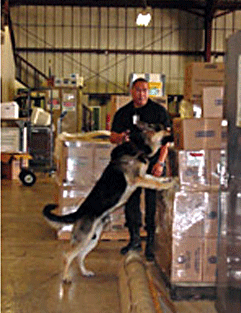Claim
USA Cargo Security Gap
 Just
as the USA Transportation Security Administration (TSA) unveiled new cargo
regulations, critics of the current security environment were also out
in force: Just
as the USA Transportation Security Administration (TSA) unveiled new cargo
regulations, critics of the current security environment were also out
in force:
"It's the fox guarding the henhouse
in many cases," William McReynolds, Airline Pilots Association said
speaking of air cargo security to Columbia Broadcasting System (CBS) News.
CBS said that it just finished an investigation
as U.S. government issued new directives designed to further tighten air
cargo security.
“Last week,” CBS News said “we
showed TSA officials the results from an elaborate test conducted to see
what packages could get through.
“A CBS News producer with a hidden
camera was sent to a shipping company near London’s Heathrow Airport,
armed with a lead-lined package that could hide a bomb.”
“The package is specially designed
so CBS News would be able to tell whether security has opened or X-rayed
it.”
CBS News said that it conducted the same
kind of air cargo experiment on three other international flights sending
two more packages on jumbo jets flying from Dulles Airport Washington
to Los Angeles.
The report concluded saying that the packages
were delivered to CBS News' offices in New York.
“In all, five of the six packages
that CBS News sent on planes were not visibly opened or inspected.
“According to CBS experts, none of
the hidden film was examined by X-ray.”
TSA’s Robert Jamison, second-in-command
at the TSA told CBS.
"I think you're not accurately representing—the—levels
of explosive detection that we have in place.
“Even without opening cargo, it can
be inspected with explosive-detection devices and bomb-sniffing dogs.”
TSA issued a directive to the airlines on
Monday October 23 that tightens the requirements for the screening of
air cargo on passenger airline flights saying:
"All air cargo transported on passenger
planes will be screened or submitted to robust layered security measures
for domestic and international air cargo."
The TSA directive applies to cargo that
is shipped by freight companies on passenger airline flights.
This latest TSA edict follows one issued
last month requiring screening for all "counter-to-counter"
air cargo—packages checked at airline ticket counters by individuals
for shipment aboard passenger flights.
TSA’s new air cargo regulations also
include 100,000 more background checks, specifically on cargo employees.
The rule requires more robust checks and
more visibility on the shipping companies and their employees. Additionally
TSA has now extended security areas at the airport to include air cargo
areas.
FT investigated one area of heightened security
mentioned in all of this as we looked into the TSA National Explosives
Detection Canine Team Program (NEDCTP).
What we discovered is that the agency indeed
has ramped up to much broader utilization of these sniffers to search
aircraft, cargo, vehicles, terminals, warehouses, and luggage.
Currently, there are 425 explosive detection
canine teams working at over 75 airports nationwide, conducting random
screening of cargo and surveillance of cargo facilities.
“TSA has increased the number of certified
explosives detection canine teams in close partnership with law enforcement
agencies, airports, and other stakeholder operators,” a spokesman
at TSA confirmed.
“Through our existing partnerships,
TSA launched an aggressive program to increase the amount of dedicated
time TSA-certified explosives detection canine teams spend on cargo screening
activities, resulting in the teams spending one quarter of their time
specifically in this critical area.”
Meantime elsewhere at U.S. gateways TSA
is tightening more loopholes subjecting U.S. airport workers – including
ramp workers, baggage handlers, gate agents, cleaning crews and retail
workers – to random security searches before they enter restricted
and secure areas in the airports.
Until now, only two of the nation’s
428 commercial airports screened ramp workers.
But the further deepening of media coverage
with more and more we assume, well-intentioned “investigators”
of air cargo, will apparently continue worldwide.
The aforementioned CBS air cargo story included
a glossary with all kinds of facts and figures about the industry including,
“What is an indirect carrier?”, “How Does TSA Inspect
Cargo?” and How Much Air Cargo Is Shipped?” among other topics.
(Geoffrey)
|



